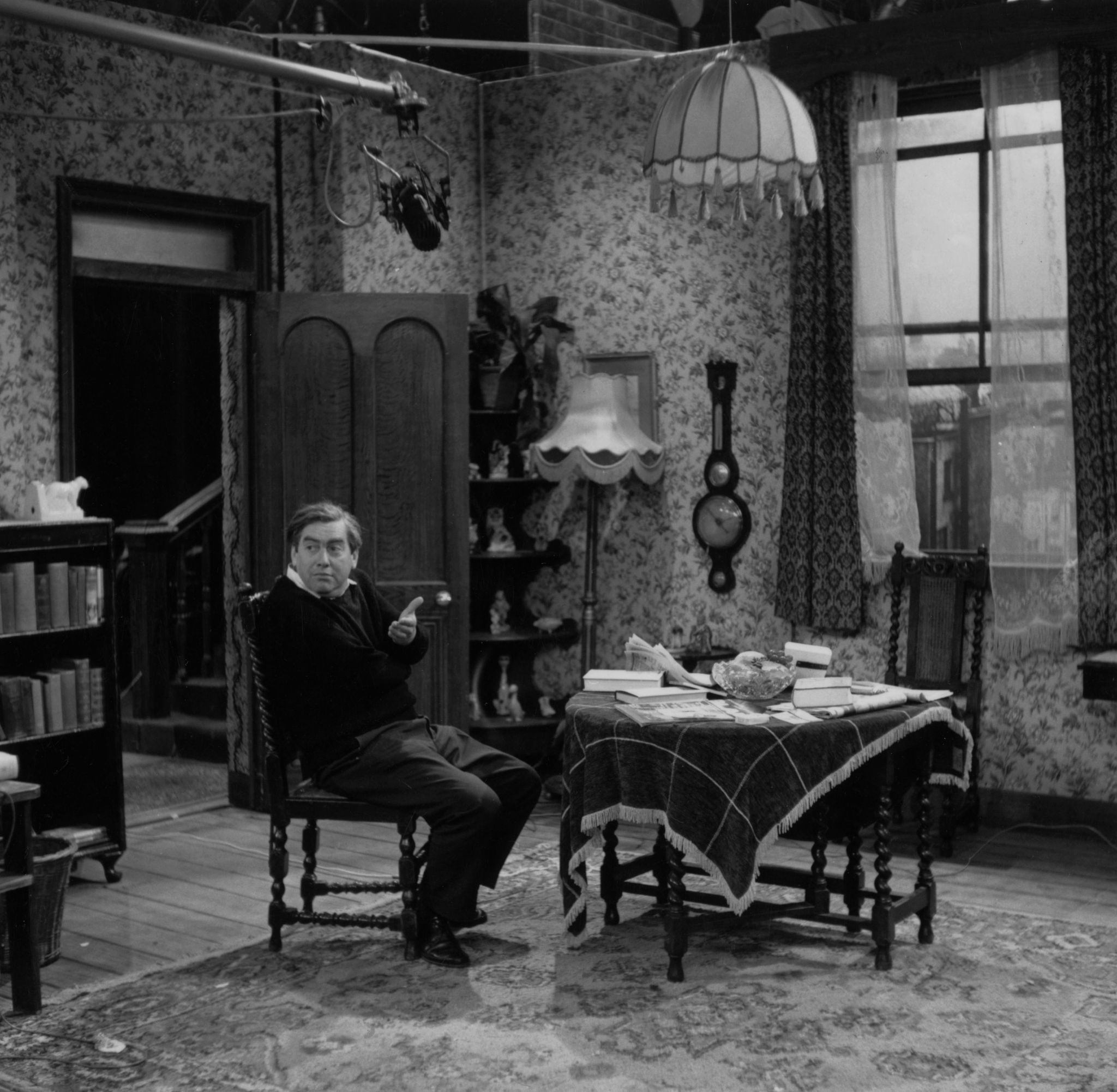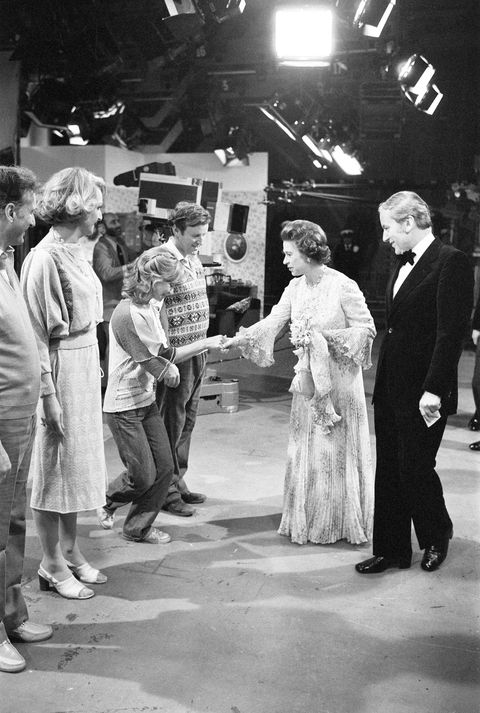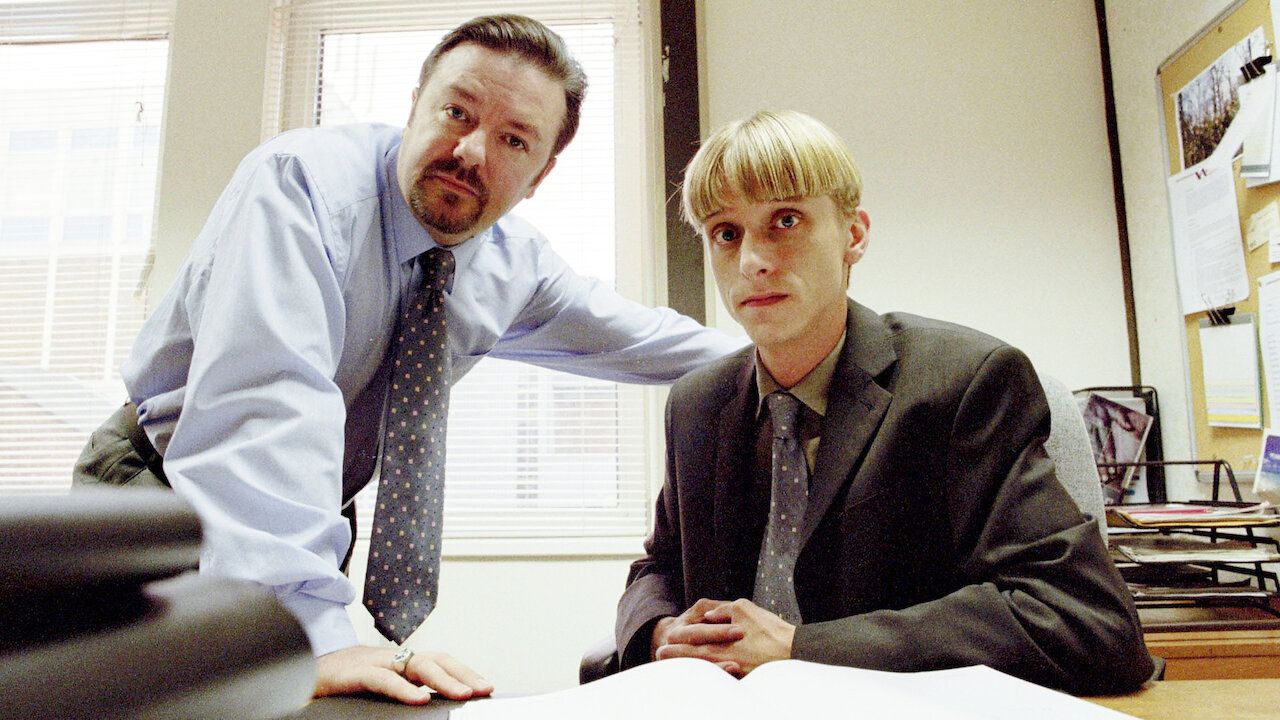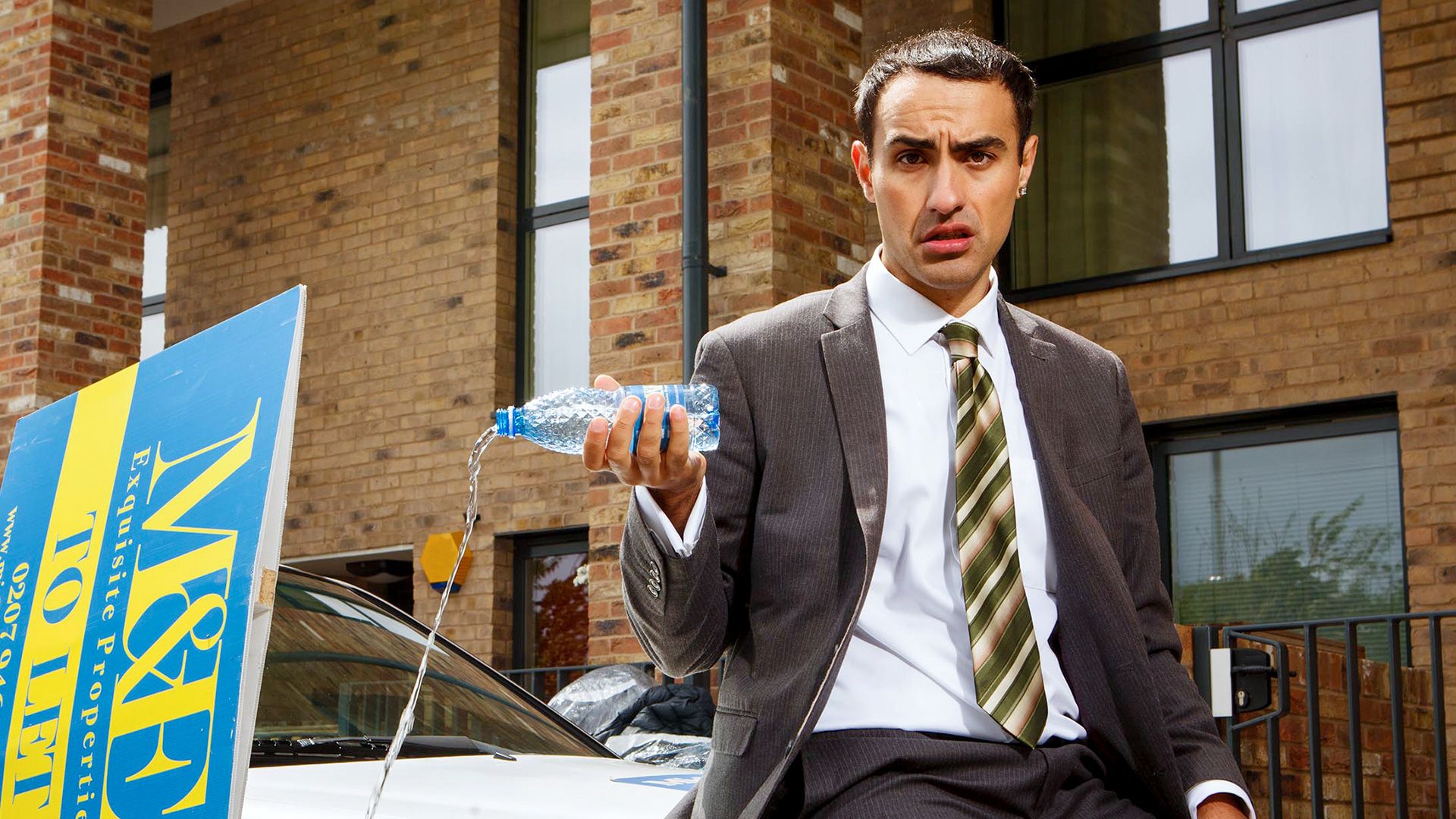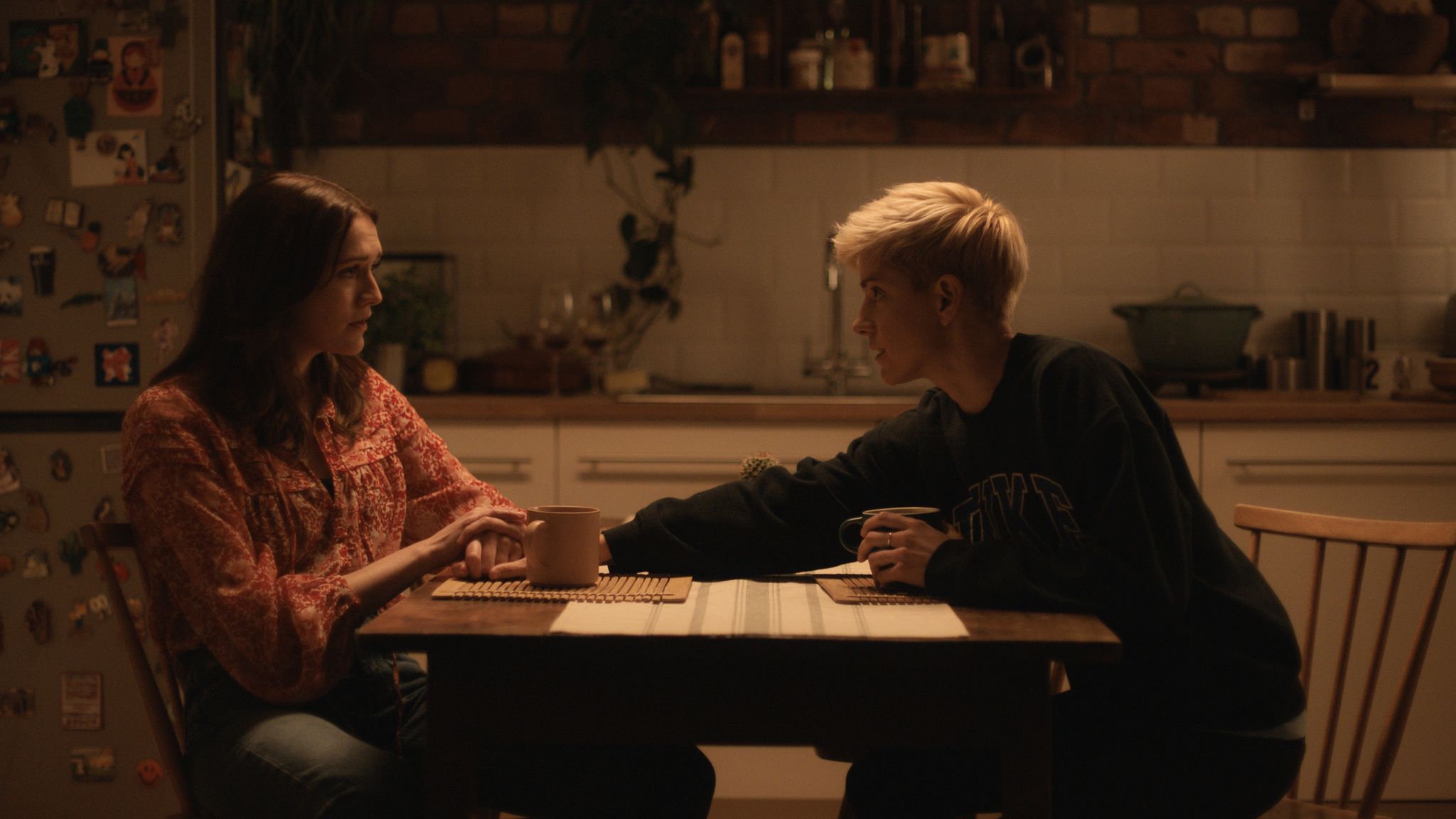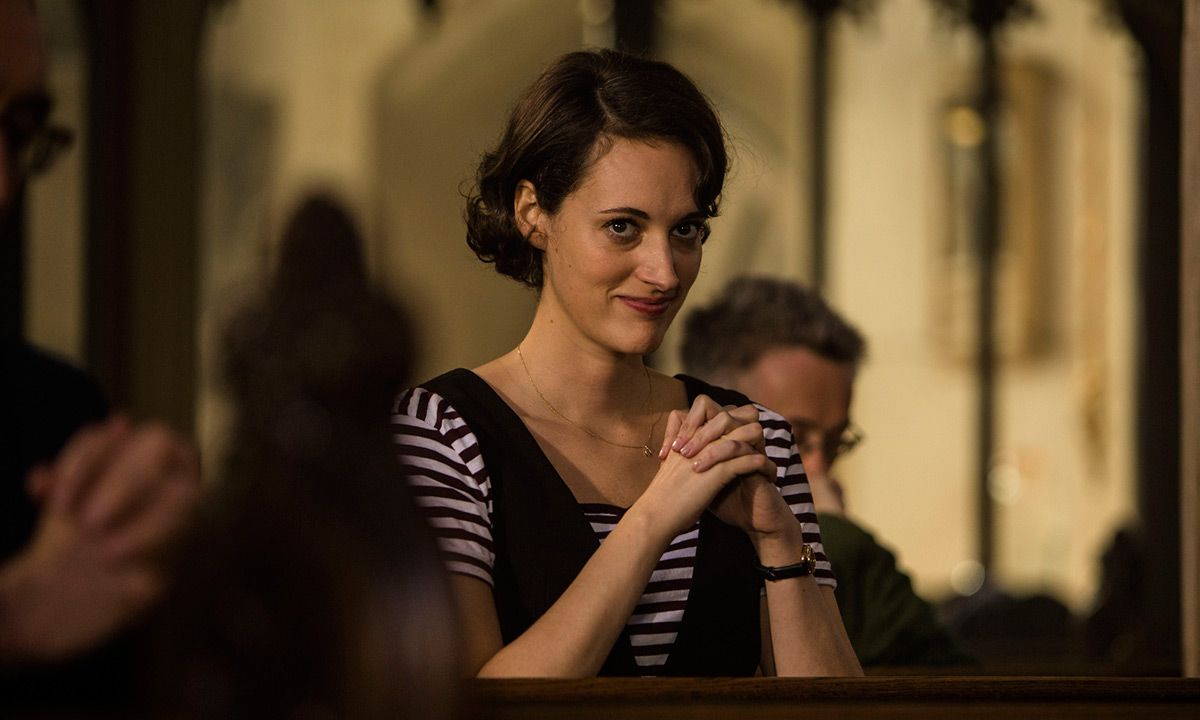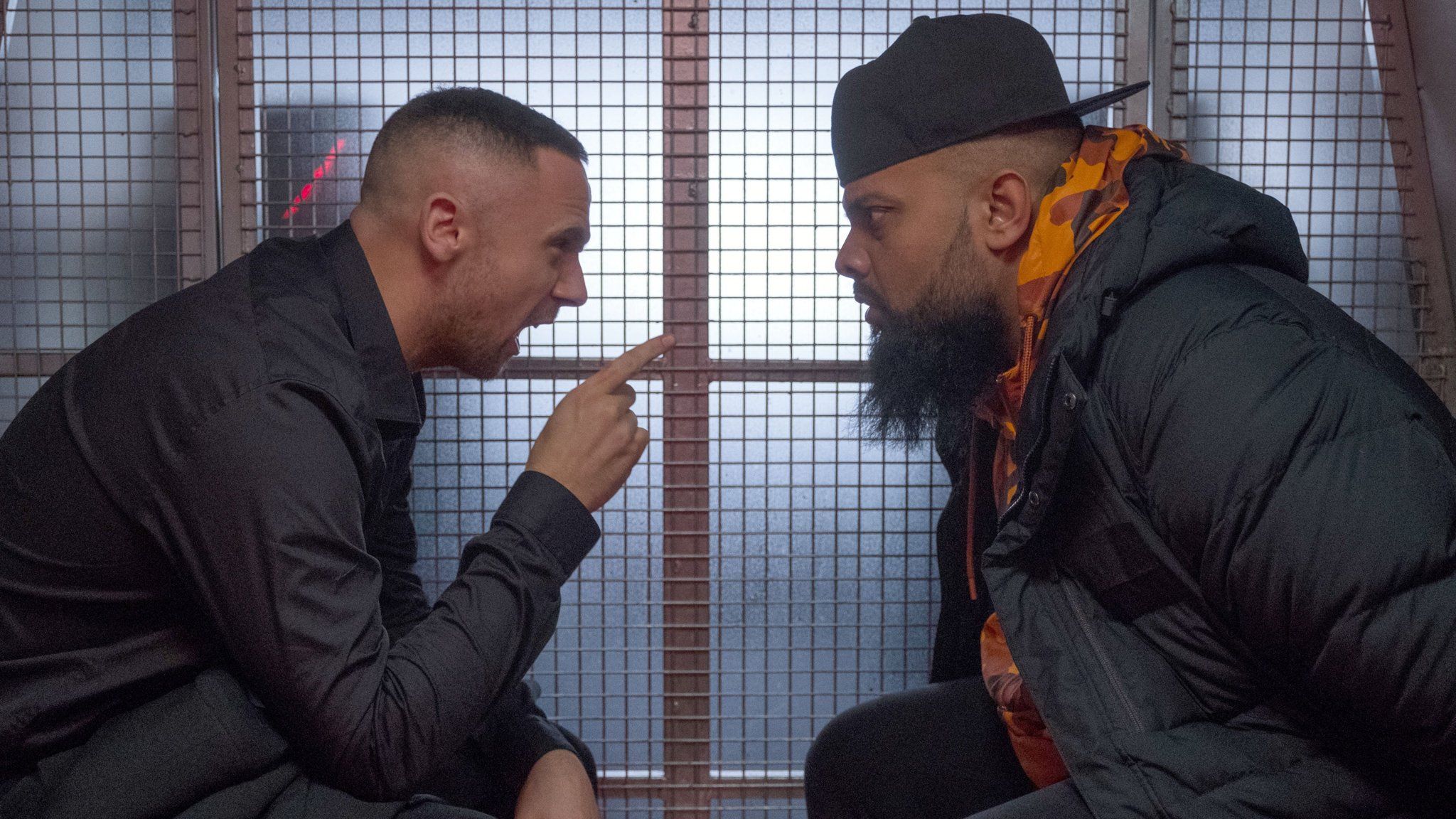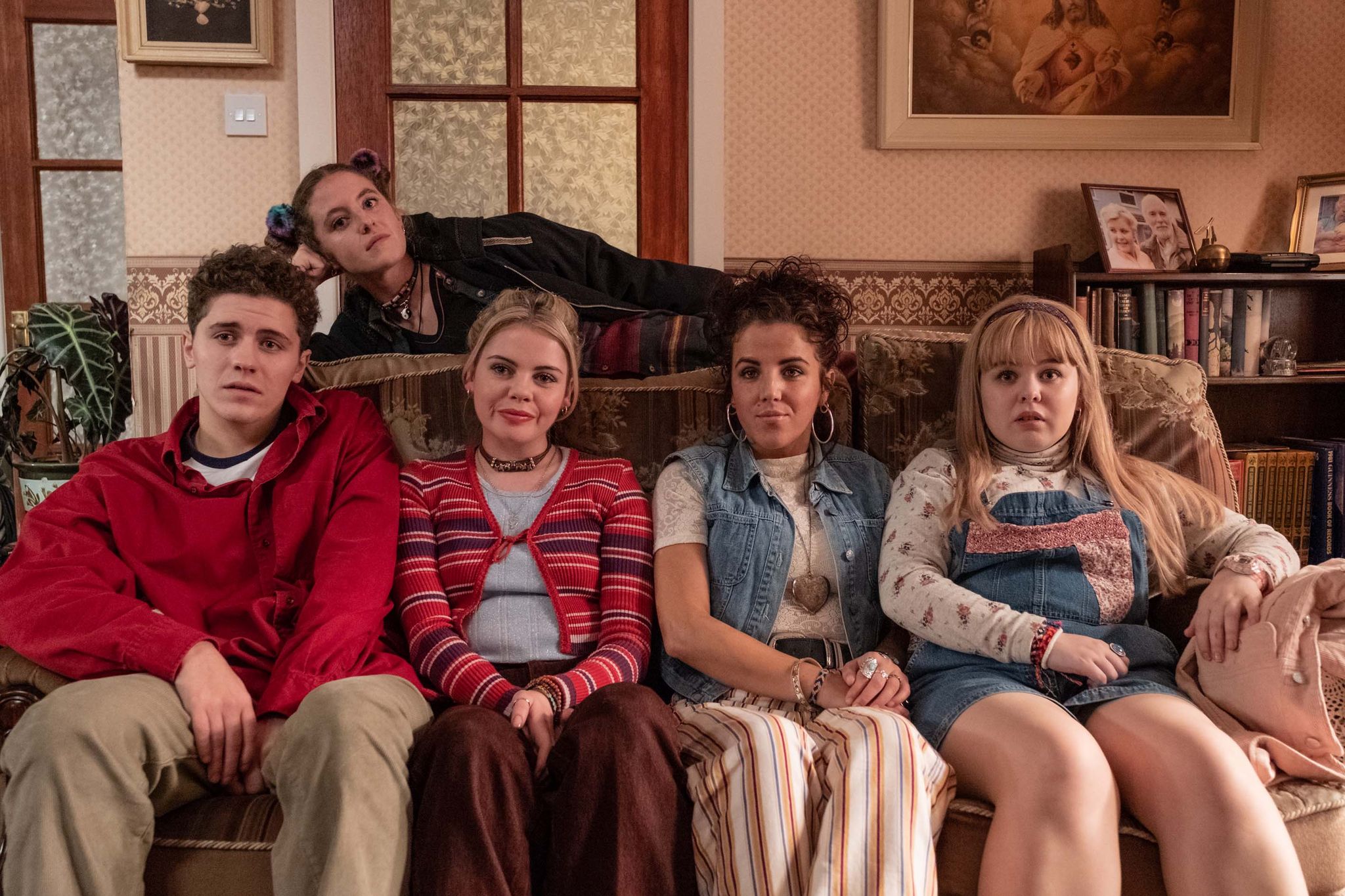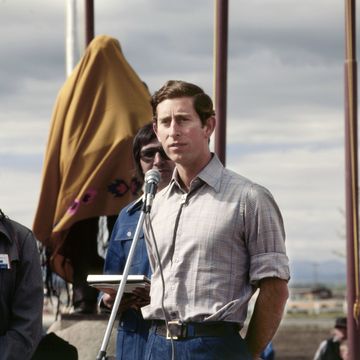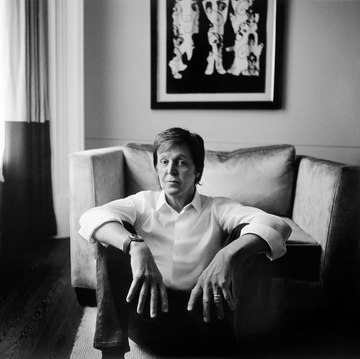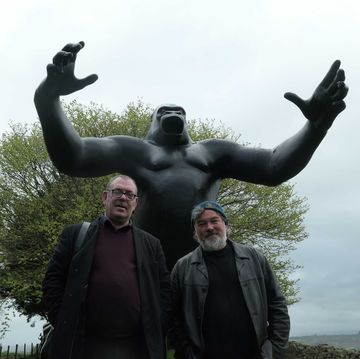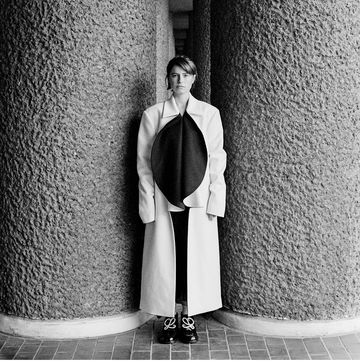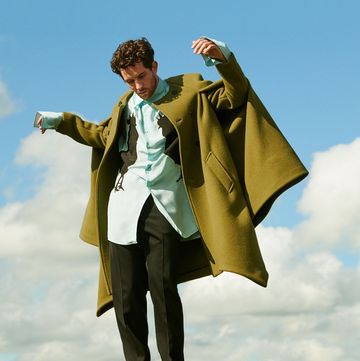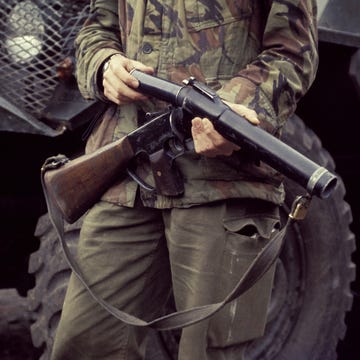If you’re at a loose end, Wikipedia’s list of extinct British sitcoms is a good wormhole to lose yourself in.
In the 75 years since the first British sitcom was broadcast live from the Alexandra Palace transmitter in November 1946, there have been some incredibly strange shows. So Haunt Me, about a family who move to Willesden and find that their new house is occupied by the ghost of a Jewish grandma. Comrade Dad, set in a dystopian 1989 where London has been annexed by the Soviet Union. ‘Orrible, which starred Big Breakfast presenter Johnny Vaughan as a cheeky chappy taxi driver. “Ultimately,” Vaughan later remembered, “it was shit.”
Sometimes all you need is the name. Never Mind the Quality, Feel the Width. It’s Awfully Bad For Your Eyes, Darling. The Gnomes of Dulwich.
These weird, lost fragments are all the more exotic because the last five years have been a golden age for British sitcoms. The density of really funny stuff we’ve had is ridiculous, but so is the shift in where those laughs come from. The British sitcom is now more thoughtful, more empathetic, more cinematic. What used to be called ‘sadcoms’ and ‘dramedies’ were actually a pointer as to how the sitcom was going to broaden out and deepen. And this revolution in how we laugh started at the bottom.
“We don't direct it,” says Channel 4’s head of comedy Fiona McDermott. “We don't say, ‘hey, we want comedy-drama’ and then we wait for pitches. There's always trends in comedy, and it's a very long lead [time] you have in this genre – some shows are in development for two, three, four years.”
That big list of deceased and forgotten sitcom series is a record of what has and hasn’t made us laugh over the last three-quarters of a century. But the way that sitcoms are made and written has changed, and who gets to make them and what they make us laugh at has changed too.
Every modern British sitcom can trace its lineage back to a comedy script that landed on the desk of the BBC’s head of variety, Pat Hillyard, in March 1953. It was a half-hour radio vehicle for the nightclub stand-up Tony Hancock, written by his friend Larry Stephens, and named Vacant Lot. There was a memo attached, written by producer Peter Eton. It was positive, if not effusive.
For the first time, the situation comedy had a name. The form itself was older, though. Pinwright’s Progress had arrived on TV in November 1946 and though no episodes survive, its DNA runs through nearly every hit that followed: for 30 minutes a week, the frustrated owner of a small shop dreams of besting his local rival, but is undermined by his useless employees. Drag-and-drop in the frustrated leader of a Home Guard unit, a frustrated East End wheeler-dealer, or the frustrated manager of a Torquay hotel.
Pinwright’s Progress was revolutionary – viewers spent time with the same characters, in the same place, every week – but had deep roots. It drew on variety and comedies of manners for its set-ups and riffs, and before that, the stand-up comedians, character comics and comedy singers of the music hall. Many of those stock characters still populate sitcoms: the fallen toff, Burlington Bertie, lives on in Fresh Meat’s arch rah JP. (Going back even further, Chaucer’s The Miller’s Tale – with its arse-kissing, fart jokes and comedy ultraviolence – is basically an early episode of Bottom.) Until the Aughts, many sitcoms still had the feel of a thumbs-in-braces, whoops-a-daisy singalong: Have I Got You Where You Want Me?; Oh Doctor Beeching!; Some Mothers Do ‘Ave ‘Em.
This history makes traditional sitcoms incredibly diverse and also deeply generic. The situation doesn’t change – a weekly family meal, say, or the shop floor of a department store – and it’s populated by characters who are familiar but amplified, grotesque or outrageous versions of someone we’ve all met before. Early on in an episode, something will change the status quo. After a big set-piece ending, where all the complications come to a head, everything goes back the way it was at the start. Nobody’s allowed to escape or learn anything.
Every nation does them differently but in Britain, where kitchen sink realism rose at the same time as the first great British sitcoms, the shadow of Steptoe & Son (1962-74) is long. The dreariness of that rag-and-bone yard two-hander runs through most British sitcoms. “To take something as bleak as an office, or a crummy living room, or a mobile home, or living in a Travel Tavern, and make it feel incredibly warm while staying true to what’s going on, is a very British trope,” says Jamie Demetriou, who writes and stars in the Bafta-winning Stath Lets Flats.
The underdog vibe in which British sitcoms are steeped is partly why we get so misty-eyed about their characters, and twitchily protective. We think of them as something between folk heroes and cultural ambassadors, the most beloved of them channelling some anarchic instinct in the national psyche. For solid bronze proof, visit Thetford in Norfolk.
There are three statues in Thetford. One is of Maharaja Duleep Singh, Lahore-born ruler of the Sikh Empire who bought and lived in a country pile in nearby Elveden in the 1860s. The second is of Thomas Paine, who was born in Thetford in the 1730s. His fiery revolutionary writings helped forge America as a nation, and he was one of the writers of the Declaration of Independence. The third is of Captain Mainwaring from Dad’s Army.
“It comes from the soul of the nation,” says Shane Allen, outgoing director of comedy commissioning at the BBC. “It’s this thing that articulates things that are in the air – all those big, classic sitcoms have said something or captured an element of our character.”
Of course, for decades, that element of our national character was mostly forged by writers from a very specific sliver of the nation. They may have gone to private school. They probably went to university. They were almost certainly a man, and they were definitely white.
This isn’t a problem which is close to being solved. In 2020 a survey showed 1.6 per cent of the UK’s TV writers identified as Black, and a Writers’ Guild of Great Britain study showed that 84 per cent of sitcoms aired between 2001 and 2016 were written entirely or predominantly by men. That wall is finally starting to crumble, though.
In the summer of 1978, Queen Elizabeth II and the Duke of Edinburgh rolled up to BBC Television Centre in their Rolls-Royce Phantom IV to attend a recording of The Good Life. Her Majesty was presented with a bouquet by Felicity Kendal’s five-year-old son, and took her place with Prince Phillip in a specially constructed royal box in the centre of the studio audience.
“Incidentally, I gather this is the first situation comedy the Queen has ever seen produced in a television studio,” the BBC’s regular royal commentator Brian Johnston explained as the Queen shook a line of hands. “She’s been to royal galas, variety shows and so on, but not a production like this.”
On BBC radio Johnston had covered Elizabeth’s coronation, the funeral of her father George VI, and two royal weddings. After the recording of ‘When I’m 65’ – in which Tom Good and Jerry Leadbetter worry about their pensions and attempt to get fit – Johnston introduced the cast and crew as they lined up in front of the sets of Margot’s front room and the Goods’ kitchen, facing a dinner-jacketed audience in a row that ran the length of the studio.
The actors and writers were at one end, then the representatives of the many interconnected backstage disciplines stood like guild leaders: the production assistant, the floor manager, the designer, the technical manager, the senior cameraman, the senior boom operator, the head of costume, the make-up artist, the senior electrician, the studio engineer and, finally, the senior supervisor.
For the first 50 years, it took this small army to make a sitcom. Its craft settled into a familiar weekly rhythm. If recording was on a Friday, then Monday would be a table-read of the new script, with any rewrites done in the afternoon. Tuesday and Wednesday were for blocking and rehearsal, and any fine-tuning between cast and writers. Thursday was for technical rehearsal with crew, and pre-recording particularly fiddly sections that could be played into the audience over monitors: scenes with children or animals, or “a particularly difficult piece of business that needed perfect timing,” according to Simon Lupton, comedy producer and co-founder of Seven Seas Films. Friday was the two-hour recording, then the whole thing started again on Monday. It was a large but well-oiled machine.
The pros of using a studio were obvious then, with price the biggest. “Shooting on location on film was massively expensive,” says Lupton. “So stuff was filmed in studios because it was cheaper and location was deemed a luxury.” But thematically, studios just worked. Sitcoms took inspiration from theatre and music hall which, in the mid-Fifties, hadn’t yet been entirely eclipsed by television. The wooden sets, the bright lights, the staginess of the whole thing was familiar. Audiences knew what to expect and how they were meant to respond.
Most British sitcoms looked roughly the same because they were all made in roughly the same way. They were shot on a brightly lit three-walled set so that a live audience could see what was going on and react to the scene in real time. Scenes ran to four or five minutes at a time and everything was filmed on multiple cameras to cover as many angles and reactions as possible in one go. It was quick and it was easy to replicate every seven days, but it also required an enormous crew and, since ‘success’ meant reaching 10 million people every week, left little room for experimentation. A lot of the time, it didn’t leave much room for subtlety either.
“Studio sitcoms used to go for big laughs, really, because they had to,” says Lupton. “You've got 200 people sitting there watching you, you need to make them laugh, because there's nothing worse than doing comedy to a room of 200 people who aren't laughing.”
Except, perhaps, doing comedy to an audience of 10 million who aren’t laughing. Studio sitcoms were gigantic, tentpoles in the broadcasting schedule that became appointment viewing for the nation. Though forgotten now, George & Mildred (1976-79), The Cuckoo Waltz (1975-80) and Oh No It’s Selwynn Froggitt (1974-78) all topped 20 million viewers. (The late Bill Maynard, who played the dim bulb Selwynn Froggitt, claimed his show’s audience peaked at 29 million. That would put it fourth on the all-time most-watched British broadcasts list, just ahead of the Apollo 13 splashdown. We might have to treat that with some caution.) Seven of the top 20 most-watched broadcasts of the Eighties were sitcom episodes. But by the mid-Nineties the old way of doing things started to make less sense.
“[The cost of] a studio comedy, per hour, is comparable to a drama on the BBC or ITV, and it's justifiable when it's delivering 10 million viewers, as those big sitcoms are more than capable of doing,” says Lupton. “But you have to make lots of them to find the gems. That's the thing – they're notoriously difficult to get right.”
By the Nineties, commissioners realised that there was an easier and cheaper way to score a hit: import them from America. Homegrown sitcoms like Absolutely Fabulous were big, but Friends, Frasier and The Fresh Prince of Bel Air were bigger. The American sitcom was shinier, more expensive, and filled with beautiful people. How could the Brits compete? The answer was to go cheaper, grittier and more real, via the front room of a council house in Manchester, and in a paper merchant’s offices near Slough.
In 1998, The Royle Family slowed and shrank the sitcom to a single room, in which nearly nothing happened. It wasn't the first to shake off the sitcom's atavistic tendencies – other sitcoms had skipped the laugh track and been shot like drama – but none were this popular: around 10.4 million people watched Denise go into labour in the family toilet in the 1999 Christmas special, as Jim sobbed.
The Office (2001-03), Lupton says, was the other pivot. When Wernham Hogg’s doors opened in 2001, it gave us something “shot entirely on location without an audience, that delivered those big laughs and set pieces, but in a very, very intelligent way”. It felt real, an inside joke that anyone who’d ever worked anywhere could get. Characters talk over each other and throw lines in from off camera. There are no wacky contrivances or improbable misunderstandings. The threat of a merger and a will-they-won’t-they romance make it hang together, but there’s often no obvious plot. There are no traditional gags or punchlines. Quite apart from that, it was extremely cheap, each episode costing as little as half as the average BBC sitcom, according to its producers.
If it sounds like an abrupt break, it was. Victoria Wood’s dinnerladies, which was shot in a studio with laughter track and stock characters, debuted two months after The Royle Family. Wood watched, aghast, as it turned her sitcom into a relic before it had even aired. After wrapping dinnerladies up in 2000, she never went back to sitcoms. They were dead, she said a few years later: “The Office was too good.”
They weren’t the only sitcoms to stretch what sitcoms could do. I’m Alan Partridge (1997-02) was a hybrid, shot on a four-walled set which cut off the actors from an audience on the other side and gave it a single-camera feel. Spaced (1999-01) piled up film and TV references, not just in the rat-a-tat script but in Edgar Wright’s frenetic, cine-literate direction, full of jokes, nods and parodies that couldn’t have been done in a studio.
Without the pressure of a live audience, writers began to change tack, too. Robert Popper, who worked as a script editor and consultant on studio sitcom The IT Crowd (2006-13), thought it was time to go in a different direction with his own sitcom, Friday Night Dinner, in 2011.
“I didn't write it as, like, gag-gag-gag-gag-gag,” he says. “I love things like IT Crowd, but I didn't want to do a show that felt bigger. That's not putting IT Crowd down, because it's fantastic, but I didn't want to make Friday Night Dinner [and] put it into that format and, therefore, the characters to be saying gags. I wanted it to feel sort of real.”
After The Royle Family and The Office, wanting things to feel “sort of real” became the sitcom’s lodestar, and studios were not real. That emphasis on veracity means you got the kids from Outnumbered (2007-16) rambling unselfconsciously, exactly like kids do, and real Bolton locals being confused by variety acts on Phoenix Nights (2001-2). Guz Khan, co-writer and star of Man Like Mobeen (2017-), recalls getting his show commissioned as "a chance to make something real".
The studio sitcoms which survived tended to wink at the audience. Miranda (2009-15) chucked in monologuing and mid-scene asides, and then there’s the Mrs Brown’s Boys (2011-), the whole point of which is the bits where actors corpse or fluff their lines and crew members drift into shot. Even the unsinkable mammy might be losing her touch, though. The 2013 Christmas special got 9.3 million viewers; the 2020 special limped to 3.8 million.
Compared to a Mrs Brown's Boys script, a typical Stath Lets Flats (2018-) screenplay is barely even recognisable as a sitcom. "The scripts are written sort of phonetically and there's no joke," says Demetriou. "The characters are all just, like, thick and flawed in their own way, and unfunny. It's kind of a daunting experience reading the script without anyone saying it, because you're like, 'This is 180 pages of people calling each other cheeky'."
Demetriou won three Baftas for the second series of Stath Lets Flats last year. He broke through while performing in the University of Bristol’s Edinburgh Fringe revue at the turn of the 2010s. In 2013, the first iteration of Stath Lets Flats was broadcast as one of three five-minute shorts he made for Channel 4’s Comedy Blaps strand on YouTube and All4. After five years of development, its first series aired in 2018. Like a lot of comedians his age, his sensibilities were formed as a teenager by endless rewatches of the sitcoms which changed everything: The Office, The Royle Family and, most of all, I’m Alan Partridge. "I’ve watched the Partridge DVD menu for 45 minutes at a time," he says.
He and the other writers of our best new sitcoms grew up with a completely different idea of what a sitcom could do and look like, and not just on the page. The dawn of lightweight, affordable digital cameras in the mid-Aughts meant a crew of two or three could now achieve what had once required dozens of studio staff. Suddenly anyone could shoot anything almost anywhere.
"It's great," says Sarah Hammond, producer on the second series of Fleabag and Daisy Haggard’s Back to Life, about a woman awkwardly edging back into society after leaving prison. "You travel light, you hop around."
That doesn’t just mean characters cover more ground. There’s now an intimacy to sitcoms which wasn’t there before, heightened by the all-pervading wobble-cam shooting style, which gives everything a documentary feel. Even a big character comedy like Man Like Mobeen has the same look as a prestige drama. Some go even further. Back to Life, Fleabag and Aisling Bea’s post-breakdown recovery sitcom, This Way Up (2019-), added letterboxing bars at the top and bottom of the screen and were shot with anamorphic lenses which, says Hammond, “allowed us to have the indie movie feel”.
It’s reflective of a deeper shift in what writers and producers want sitcoms to do. Rather than being machines that crank out gags, they’re miniature movies reaching for gravitas as well as laughs. More and more, that "realness" Popper describes means emotional openness and rounded characters who, unlike their studio forebears, don’t act like they’re in a sitcom.
In the Seventies and Eighties, Liverpudlian writer Carla Lane’s subtle, empathetic sitcoms about women yearning for fulfilment and excitement, like Butterflies (1978-83) and Solo (1981-82), confused reviewers and audiences. Now, though, they’d sit comfortably next to This Way Up or Mae Martin’s Feel Good (2020-21), about a stand-up and recovering addict whose new girlfriend insists they rejoin Narcotics Anonymous. The new wave of sitcoms tend to have an overarching, emotionally charged arc built into them from the start. Even big character sitcoms, like Stath Lets Flats, are poignant as often as they are funny.
Feel Good was a big cult hit on its recent jump to Netflix from Channel 4, in large part because of the should-they-shouldn’t-they queer romance at its heart – and also being really, really funny.
"What I like about a narrative thing is the richness of it, and being able to see somebody’s whole world," says Martin. "And I think that when you can identify with somebody and empathise with them it’s a lot easier to understand some of these things which on paper you might feel you wouldn’t relate to, but of course we all do."
Their Feel Good co-star Charlotte Ritchie, also of new golden age hits Ghosts (2019-), Fresh Meat (2011-16) and Dead Pixels (2019-), agrees.
"I think also there’s a real truth that in life there’s a lot of jokes, and actually more than anything we use humour as a deflection technique and I think that that’s so much more realistic in some ways than people being articulately written," she says. "Personally I’m such a big fan of the genre in general because it feels more true to life."
Demetriou and Martin's generation, raised on "very sophisticated American HBO shows and the like, and indie films," are, Allen says, "wanting to go for those deeper dives into characters, so rather than have a sort of a two-dimensional Brittas Empire kinda guy who's just sort of uptight, they'd be more interested in the complexities and naturalistic kind of thing".
Aisling Bea ums and ers about the idea of being part of a particular sitcom generation with the likes of Martin, Michaela Coel and Phoebe Waller-Bridge. "I mean, it’s hard to deny the word ‘generation’ when we’re literally all around the same age," she says. "It’s exciting though, and they’re all people I’m inspired by and I look up to. And know; I know what they’ve been through and worked with, and it’s a lot to do. There aren’t lots of us that have written and been in our own things, and it’s a lot."
The emergence of so many writer-performers in the last five years – and particularly people she has gigged with, been to the same Edinburghs as, shares friends with – is helpful.
"It is a lovely thing to be able to talk to Phoebe or Michaela about how it is, your vision, who to let in, who to not let in, whose criticism to listen to and whose notes to listen to, all that kind of stuff."
When the old money-new money culture clash To The Manor Born (1979-81) was pulling in more than 20 million viewers in 1979, strikes at ITV meant there were only two channels you could watch in the UK. Now, the entire Freeview network could fall over and you could be forgiven for not noticing because you were on Netflix.
Streaming services have changed everything in the last five years, and sitcoms are gold for streamers. Viewers are far more likely to rewatch comedy than drama or factual programming, says McDermott – they’re "the bedrocks of what makes an SVOD [streamed video on demand] channel really last," and key to All4’s success. Its collection of new and classic Channel 4 sitcoms is buttressed by American behemoths Seinfeld, Malcolm in the Middle, Scrubs and Community, and the BBC’s iPlayer is stocked with dozens and dozens of new and classic sitcoms from here and abroad. Compare that to the unloved ITV Hub, which has only five full sitcom series permanently available.
All4 and Netflix helped Derry Girls and Friday Night Dinner become fixtures, says McDermott, ensuring they "popped in ways I don't think they would have done maybe four or five years ago". Similarly, Friday Night Dinner only went overground after a few years of gradually building its cult following: "Series five was when suddenly things got very, very big," says Popper, "and everyone sort of knew what it was, and it was a thing and people were getting tattoos of the characters."
If a channel backs a show which gradually gets traction on Netflix or Amazon Prime, McDermott says, "it starts reaping the rewards over a really long period of time" and pulls viewers toward the channel that first commissioned it. The streamers also export British TV more quickly and completely than before, says Allen.
"I think that paved the way [so] that shows like Catastrophe and Fleabag can travel the world now, unfiltered," he says. "And they get the British voice and the British sense of humour and the British setting and they are willing to embrace that."
"The streamers have allowed us to make the world a little bit smaller," agrees Hammond. More than that, they influence what makes it to development, and how. The data that streaming platforms can provide to their channels is key in commissioning and marketing, and "tailoring stuff to the right people," McDermott adds.
The iPlayer, All4 and YouTube can give sitcoms a far longer tail and take away the immediate pressure bad viewing figures can put on a new series. They've also become a testing ground for newer writers and performers, who can work up to the standard six-part half-hour sitcom. Chewing Gum (2015-17), Stath Lets Flats, E4’s Maxxx (2020-) and Dead Pixels all graduated from Channel 4’s Comedy Blaps strand, and the success of 15-minute shorts like Staged and Pls Like on iPlayer suggests that the fact viewers are now used to short content on YouTube and IGTV has permanently warped what shape and size sitcoms can be.
For creators, the necessity of bankrupting yourself while flogging your guts out over an Edinburgh show – the traditional British comedy talent-harvesting ground – is less clear when #HoodDocumentary creator Kayode Ewumi, Guz Khan, and People Just Do Nothing (2014-18) forerunner Wasteman TV all skipped it and got spotted elsewhere.
The BBC’s new slate of sitcoms certainly suggests that’s the future. Some of the cast of the hyperactive PRU, about a set of school troublemakers, came through Instagram Live, and both the ASMR-inflected dashcam commentary of Zen School of Driving and Adjani Salmon’s Dreaming Whilst Black, about a naïve and thwarted filmmaker, are reworked and expanded from YouTube series. It’s an appealingly democratic shift, especially as the expense of Edinburgh can make it a particularly middle-class and white pool.
“It’s a weird time to start trying to be a comedian or whatever,” says Khan, who was a humanities teacher in his late twenties when he was spotted after his riffs on Jurassic World’s deeply ill-advised contraction of Pachycephalosaurus went viral on Facebook. “You just don't do that, where I'm from anyway.”
Hammond now treats YouTube, TikTok and Instagram as a shop window. "Watching a group of people do it first on YouTube and finding their feet and finding their voice is great, because then you can think of all sorts of brilliant situations you could put them into," she says.
Others have managed to skip mainstream broadcasters altogether. Andrew Osayemi and Debra Odutuyo pitched their sitcom, Meet the Adebanjos (2012-16), about the ups and downs of a British-Nigerian family in Peckham, to broadcasters before deciding to fund it themselves to the tune of £10,000 an episode – Odutuyo even sold her car to help – then put it up to watch online. It’s since found a home on Netflix. Lockdown three saw the launch of Petrichor, a mockumentary about a doomed Kickstarter-funded short film which boasts established performers including Ellie White, Lolly Adefope and Katy Wix.
The broadcasters still have most of the power, but the sitcom world is slowly becoming less top-down. It’s not democratic yet, but it’s definitely slightly more democratic.
That applies when it comes to addressing the glaring whiteness of British sitcom history too. The last five years have seen more sitcoms written by Black British and British Asian writers than there were in the previous 70 years. Then again, it’s a low bar. Before the turn of the millennium there were as many British sitcoms about people being accidentally shot into space (Red Dwarf, Come Back Mrs Noah) as there were featuring an Asian lead (Tandoori Nights, Tottenham 2).
Black writers have detailed exactly how difficult it is to make progress in a white industry. Michaela Coel’s Chewing Gum was a big, Bafta-winning success, but its production was fraught. "The producer rang to say the commissioner thought I needed co-writers urgently," Coel said in her 2018 McTaggart Lecture. “I got the call in Boots. I was picking up some tights, then found myself sobbing into the tights and discreetly leaving them there, for someone else to buy.” Coel wrote 41 drafts of the script before it was accepted.
Her experience isn’t uncommon among the few Black writers who’ve been given a chance on their own sitcom. Daniel Lawrence Taylor, who wrote and starred in ITV2’s Time Wasters (2017-19) about a time-travelling jazz band, had one of his episodes completely rewritten without his knowledge and found an executive producer “so surprised at the quality of the writing that he assumed my white script editor was responsible for it.”
“I was trusted so little that I found it easier to get a lot of my ideas through by pretending that they were either hers or co-signed by her,” he wrote last summer.
Lawrence described sitcoms and the production structures around them as “a white space,” and after the Black Lives Matter protests of last summer the industry is being forced to examine itself. In June, an open letter signed by more than 5,000 TV and media professionals – actors, writer, directors, producers, broadcasters – called for a radical overhaul of the UK’s TV and film industries.
The BBC’s first British Asian sitcom only arrived in 2012, and it turned out to be an indicator of the sea change in sitcoms. Adil Ray’s Citizen Khan (2012-16), a big, daft, family sitcom about the eponymous and self-appointed head of his Pakistani community in Birmingham, won Baftas and big ratings, but wasn’t welcomed by everyone.
Labour MP Dr Rupa Huq hammered it in the Commons, and placed Citizen Khan in the same lineage as the much-loathed race-hate sitcom Love Thy Neighbour: “It is the everyday tale of a Birmingham family of Muslims, but they are really quite backward… They are not quite cutting off people’s hands, but I could imagine that being in a future episode.” Man Like Mobeen’s Guz Khan was “flabbergasted” by it.
“It hadn't caught up in time to where we were, d'you know what I mean? The people, the community and the life we were living… I thought that it was a bit of a mockery of the community, and our people felt that as well.” He showed his mum Citizen Khan for a second opinion. “She was like, ‘Oh yeah, this is like On the Buses’. I was like god damn, is this the regression that we're going through in this country in terms of representation?”
The unease around Citizen Khan was made worse by its unashamedly old sitcom vibe: a live audience, big whacky characters, Ray wearing a fake beard. When Guz Khan came to make his own sitcom, Donald Glover’s Atlanta and its frank dissection of race in America "was a big thing," he says. "I was thinking, I've had these thoughts before, and here's someone who's brought it to fruition.
“Watching comedy for many, many years, and whether [it was] white, Black or Asian references, working class references always felt a bit smelly to me,” Khan continues. “That's not being written by, that's been written for, do you know what I mean? They tried their best. But what really used to irk me is that it just wasn't representation in a real way.”
The old way of making sitcoms had to wither to let more voices in, and it’s not a coincidence that just as British sitcom has become less male, less middle class, less white, less straight and less London-centric, it’s also been far funnier and more original than it has in decades.
Look at Derry Girls, says Fiona McDermott. It’s a traditional working class family sitcom and pulls some familiar strings: teenage boredom, dysfunctional family life and the like. “What is radical about it,” she says, “is it's a female voice, and a female gang, in a really underserved part of the country.”
Allen, who’s Northern Irish, is particularly pleased at Derry Girls’ success after decades of hearing that English viewers wouldn’t understand his accent. “It's taking those very specific voices and people whose experiences that you can then commission and amplify and go: this is original, you haven't seen anything like this before,” says Allen. Audiences faced with infinite choices don’t want sitcoms that feel “a bit fucking done.”
Writers and performers with disabilities, who had been completely shut out of sitcoms, are also beginning to make headway. Jerk (2019) was great: a black comedy in which Tim, who has cerebral palsy, cynically exploits the sympathy of everyone around him. Compare it to Gervais’ cloying and gluey Derek (2013), in which Gervais plays a man who appears to have a learning disability. One feels like the future; the other feels like the dim past.
The ‘situation’ bit of ‘situation comedy’ hasn’t really changed, but the perspective has. All these changes – the look of them, where the camera puts you, who gets to make the jokes, and how – have remade what British sitcoms can do. It’s a reflection of how the country’s changed, too. It often doesn’t feel like it, but the sitcoms we make and watch show we’re more interested now in hearing from people who’ve been ignored, that we’re more attuned to how other people’s brains actually work, and that we’re more ready to talk about difficult, awkward subjects with a bit of nuance. Sitcoms can do that now.
“It’s one of the best forms for tackling some of those bigger issues, whether it is mental health, whether it is inequality, whether it is female representation, whether it's something like our response to Brexit,” says McDermott. “If we don't do that, we just risk drowning in misery.”

